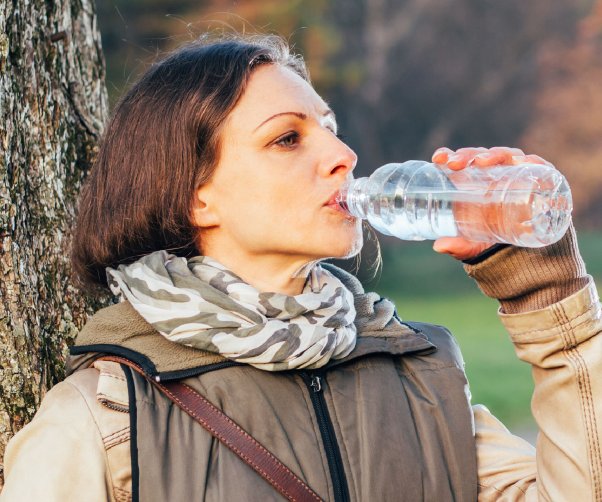
Eight Tips to Stay Hydrated—Especially in Winter
It’s cold outside, so we’re a lot less likely to drink enough water during the day. In the summer, we have plenty of reminders (scorching sun, anyone?) to hydrate and monitor our fluid intake. In the winter months, though, factors such as dry indoor air, reduced feelings of thirst and the fluid we lose simply by breathing can all lead to dehydration.
Anytime we sweat or use the restroom, our bodies lose water. It’s often harder to notice when we sweat in colder weather, so we don’t always see the signs of cold-weather dehydration creeping in. Studies show that even minor dehydration—the point at which we begin to feel thirsty—can cause difficulty concentrating, memory lapses and bad moods. Low water intake is also linked to chronic kidney disease, joint pain, high blood pressure and risk factors for heart disease and stroke.
Why Staying Hydrated is Crucial in the Winter
“Consuming enough fluids is critical for our bodies any time of year, and especially during the winter when it can be harder to keep our hydration up,” said Leslie Ely, registered dietician at Methodist Healthcare. “Water is essential to our bodily functions, from transporting nutrients and removing waste to supporting the immune system and maintaining blood pressure. In addition to being an easy lift, drinking water throughout the day is one of the most effective things you can do to improve your overall health and well-being.”
How Much Water Do We Need?
While the amount of fluid, ideally water, our bodies need each day varies from person to person, the U.S. National Academies of Sciences, Engineering and Medicine suggests a daily intake of 15.5 cups (almost two full 2-liter bottles!) for men and 11.5 cups, or 2.7 liters, for women. For a more personalized estimate of recommended daily ounces, take your weight in pounds and divide that number in half. The resulting number is your target fluid intake, in ounces.
SUBSCRIBE TO OUR BLOG
and you'll receive more health & wellness tips right in your inbox.
SUBSCRIBE NOW8 Evidence-Based Tips to Boost Your Hydration
To help the Healthier 901 community stay hydrated all year round—and especially during the colder months—we’ve pulled together eight evidence-based tips for you to try. These tips are simple, practical, and easy to incorporate into your daily routine, making it easier than ever to stay hydrated.
1. Set a Goal and Make it Easy to Reach
Using the estimates and estimator tool above, or after chatting with your primary care provider, determine an appropriate fluid intake goal for yourself. Then, take steps to help you hydrate wherever you go, such as carrying a refillable water bottle with you at all times and keeping a designated water glass on your desk, by your bedside or anywhere you’re likely to sit for extended periods of time.
2. Snack (and Sip) on High-Fluid Foods
Incorporate water-rich foods, such as citrus fruits, cucumbers, tomatoes and green leafy vegetables, into your diet, and look to homemade, low-sodium soups as a great additional way to increase your fluid intake.
3. Warm Up from the Inside Out
If you have difficulty drinking cold water during cold weather, shift to warm water or other warm beverages, such as herbal teas or broths. All of these liquids count toward your daily fluid intake—and they can also help heat you up!
4. Cool it on Caffeine and Alcohol
Too much caffeine can lead to dehydration, as it flushes water and electrolytes from the body. Alcohol also poses hydration risks, as it can interfere with our perception of cold and increase the risk of hypothermia. If you do drink alcohol or caffeine in colder months, don’t count those ounces toward your daily fluid intake goal, and instead balance them out by drinking additional water.
5. Savor the Flavor
Are you struggling to down enough ounces of plain water? Add slices of lemon, lime, orange, or other fruit to create a more flavorful taste. You can also add a burst of flavor using packaged water enhancers—just be sure to avoid sweeteners and added sugars!
6. Layer Up
Heavy coats and bulky clothes can lead to excessive sweating and fluid loss, which can be more challenging to detect when it’s cold outside. Layer your clothing whenever possible to better regulate your body temperature and avoid dehydration.
7. Add a Humidifier to the Mix
Central heating dries out our indoor spaces during cold months, which results in increased water loss through our skin and respiratory system. Consider putting a humidifier in your bedroom or central living space to add moisture back to indoor air, aiding overall hydration and helping you breathe easier.
8. Keep an Eye on Your Output
To determine whether you’re getting enough water and other fluids, it’s a good idea to keep an eye on the color of your urine. Light-colored urine indicates proper hydration, while dark urine often signals the need to drink more H₂O.
Take Control of Your Hydration
By putting these tips into practice and going the extra mile to drink more water during cold weather, you can keep your body hydrated and healthy through the winter months, and all year long. For some added accountability (with fun folded in along the way), take the 21-Day Hydration Boost journey. This journey, available free of charge at www.healthier901.com or through the Healthier 901 app, provides daily hydration challenges, tips, and a supportive community to help you stay on track with your hydration goals.
Related Articles


